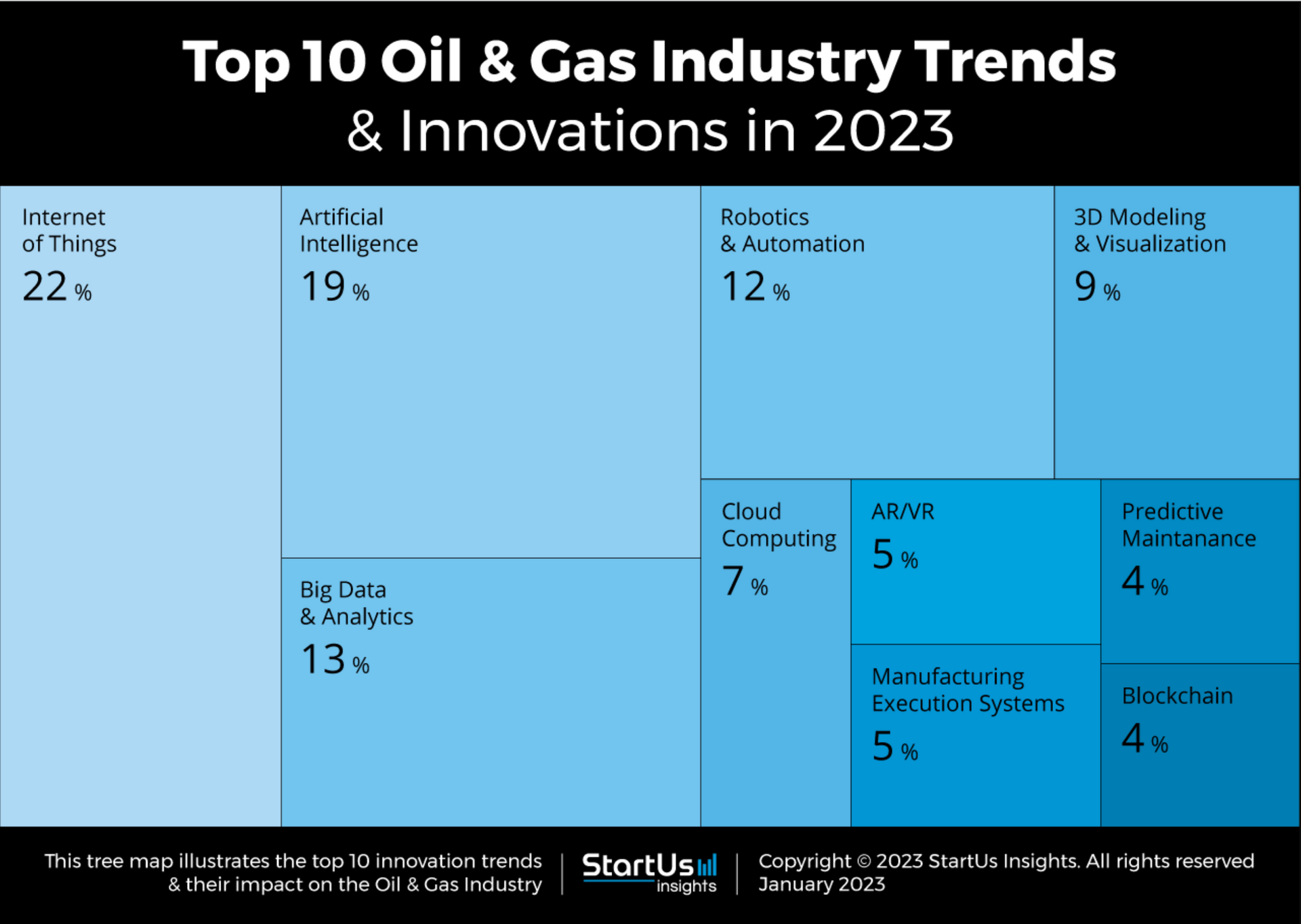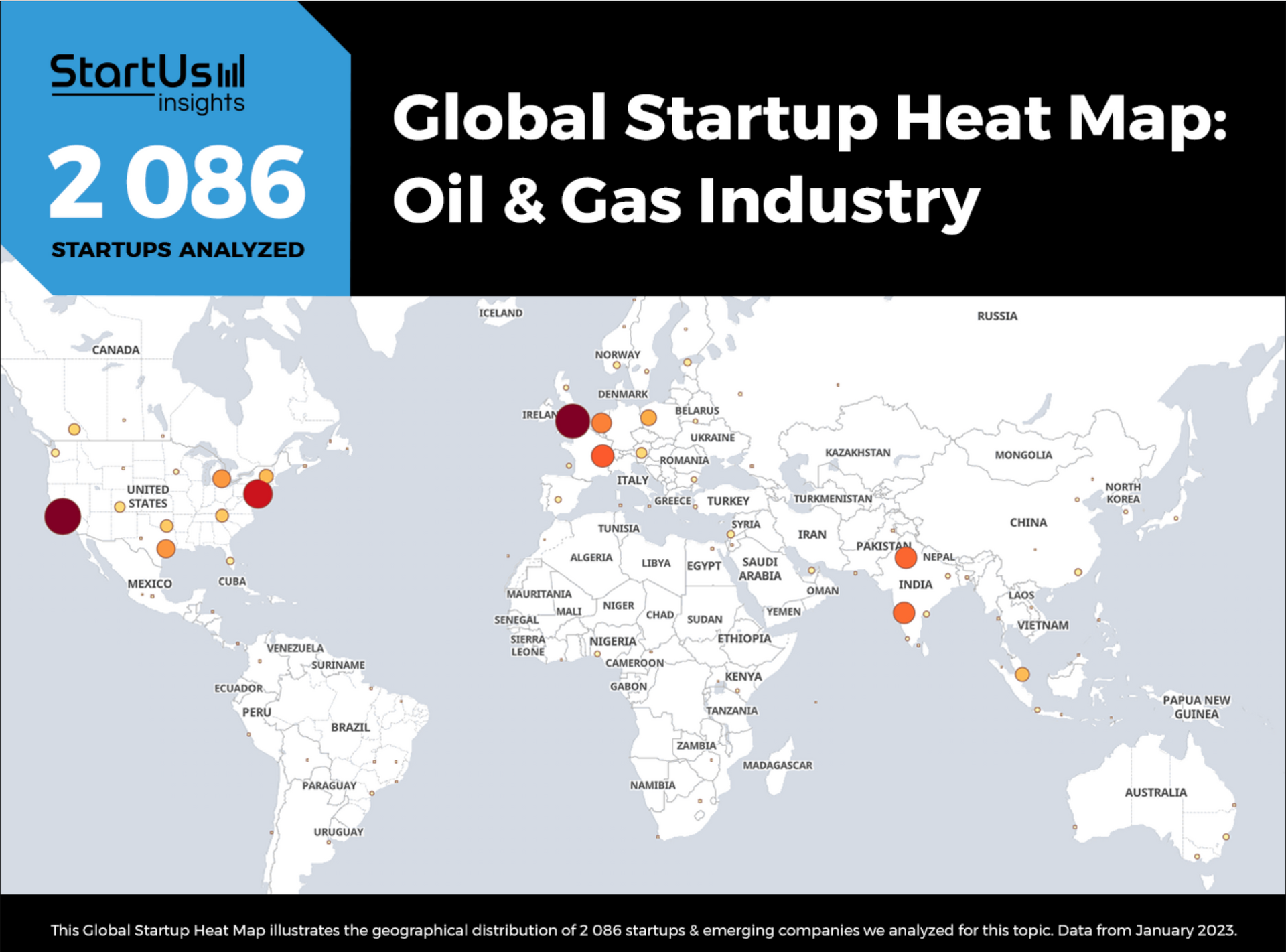Emerging oil & gas industry trends are making the industry more efficient, safer, and smarter. To this end, companies explore ways to efficiently and competitively digitize, automate, and solve complex sub-surface engineering challenges. For example, Artificial intelligence (AI) algorithms provide a competitive edge as well as enable oil & gas companies to increase oilfield or well productivity. Further, the gradual adoption of advanced robotics and data management practices accelerates processing times and reduces the need for human labor.
Innovation Map outlines the Top 10 Oil & Gas Industry Trends & 20 Promising Startups
For this in-depth research on the Top Oil & Gas Trends and Startups, we analyzed a sample of 2 086 global startups and scaleups. Thanks to data-driven innovation intelligence, this report gives you a strategic overview of emerging technologies & startups in the oil & gas industry. These insights are derived by working with our Big Data & Artificial Intelligence-powered StartUs Insights Discovery Platform, covering 2 500 000+ startups and scaleups globally. The platform delivers an exhaustive overview of emerging technologies within a specific field and identifies relevant startups and scaleups that matter.
In the Innovation Map below, you get an overview of the Top 10 Oil & Gas Trends and Innovations that impact companies worldwide. Moreover, the Oil & Gas Innovation Map reveals 20 hand-picked startups working on emerging technologies. To explore custom insights, get in touch.
Top 10 Oil & Gas Industry Trends
- Internet of Things
- Artificial Intelligence
- Big Data & Analytics
- Robotics & Automation
- 3D Modeling & Visualization
- Cloud Computing
- Augmented & Virtual Reality
- Manufacturing Execution Systems
- Predictive Maintenance
- Blockchain

Tree Map Reveals the Impact of the Top 10 Oil & Gas Industry Trends
The Tree Map below illustrates the impact of the Top 10 Oil & Gas Industry Trends. The Internet of Things (IoT) and artificial intelligence form the largest oil & gas industry trends. Big data analytics, cloud technology, predictive maintenance, and manufacturing execution systems enable vital data management and analysis tools that significantly improve overall operational efficiency. Further, AI enables robotic applications in oil rigs and refine oil well imaging processes. O&G startups also develop blockchain solutions that offer visibility and transparency across the entire oil & gas value chain. Finally, augmented and virtual reality technologies improve worker safety and enable remote operations and virtual training.

Global Startup Heat Map covers 2 086 Oil & Gas Startups & Scaleups
The Global Startup Heat Map below highlights the global distribution of the 2 086 exemplary startups and scaleups that we analyzed for this research. Created through the StartUs Insights Discovery Platform, the Heat Map reveals that Europe & the US are home to most of these companies while we also observe increased activity in India as well as Singapore.
Below, you get to meet 20 out of these 2 086 promising O&G startups & scaleups as well as the solutions they develop. These 20 startups are hand-picked based on criteria such as founding year, location, and funding raised. Depending on your specific needs, your top picks might look entirely different.

Top 10 Oil & Gas Industry Trends in 2023
1. Internet of Things (IoT)
The oil & gas industry utilizes the IoT to improve production, optimize equipment, ensure worker safety, and monitor remote areas. Sensors placed inside wells, blowout preventers (BOP), and choke valves enable real-time data collection. Using this data, O&G startups identify faulty equipment quickly, helping field engineers predict and react quickly. IoT solutions allow oil & gas facilities to minimize maintenance costs and gain detailed visibility into their equipment or processes.
Sensital provides a Real-Time Monitoring Platform
Australian startup Sensital provides solutions to extract maximum value out of the IoT ecosystems for many industries. The startup offers its IoT platform iBOTics that automates control, remotely monitors, and initiates maintenance tickets. This also improves the safety, reliability, and efficiency of the wells, pipelines, and industrial equipment. iBOTics also helps oil & gas operators minimize the overall operating expense (OPEX) and maximize the return on investment (ROI).
Zyfra builds an Industrial IoT Platform
Zyfra is a Finnish startup that implements industrial digital solutions for the oil & gas industry through its proprietary cloud-based IIoT platform. The startup’s IIoT products for upstream oil & gas include their field development platform Geonaft. The platform supports precision drilling, production scheduling, artificial lift, and predictive maintenance, among others. Zyfra’s IIoT solutions further provide real-time insights for O&G startups, improving efficiency and worker safety.
2. Artificial Intelligence
The oil & gas industry increasingly applies AI and data science to solve complex problems in upstream, midstream, and downstream operations. AI-enabled platforms support decision-making with insights from predictive, prescriptive, and cognitive analytics. In this way, AI helps petroleum engineers and oil & gas industry managers discover and implement new exploration & production ideas on the field to increase ROI.
Neudax provides Intelligent Decision Support for Upstream O&G
Neudax is a US-based startup that provides AI solutions for upstream oil & gas companies. The startup helps field engineers develop their resources more confidently and efficiently. The startup’s AI platform FracDax incorporates advanced analytics and data science, such as deep learning and reinforcement learning (RL). FracDax allows oil & gas operators to analyze thousands of oil-well parameters, assess completion options, and formulate refracturing solutions.
Nesh designs an AI-powered Chatbot
US-based startup Nesh designs an AI-powered chatbot for the entire oil & gas value chain. The startup’s Nesh virtual assistant collects data from multiple sources and answers industry-related questions using natural language processing (NLP). Nesh enables field operators to solve diverse problems related to various oilfield technologies and operations. The chatbot also provides relevant insights and uncovers new knowledge from the data to enable on-site operators to make fast and informed decisions.
3. Big Data & Analytics
Everyday operations in the oil & gas industry generate large volumes of unstructured data. Big data platforms help the industry’s data analysts draw insights from production and performance data. This is also useful for engineers looking to optimize production and ensure the safety of reservoirs. Further, historical data of previous operations better train and test AI-driven algorithms and models. By using big data analytics, the oil & gas industry derives more value from everyday decisions to reduce operational costs and the industry’s carbon emissions.
Welligence offers Data-as-a-Service (DaaS)
Welligence is a US-based startup offering big data and AI solutions for the oil & gas industry. The startup’s AI platform provides engineers with data analytics dashboards, visualization tools, production forecasts, and valuation models. Welligence’s platform extends to a subscription-based Data-as-a-Service (DaaS) that integrates with data from any source. Broadly, the platform empowers engineers and energy operators to make better strategies at an asset or a company level.
Phoenix RDS provides Drilling Optimization
British startup Phoenix RDS leverages big data & analytics for waterflood, production, and drilling optimization. In addition to reservoir modeling algorithms, Phoenix RDS also offers optimization workflows for enhanced oil recovery (EOR). These allow oil & gas asset operators to increase reservoir sweep efficiency and reduce injection volume requirements. This, in turn, enables oil companies to reduce costs and increase asset value.
4. Robotics & Automation
Often, oil & gas operators work in complex and rugged environments, posing a significant risk to human safety. To address this risk, the oil industry is adapting to robotics & automation solutions to increase workplace safety as well as the speed of operations. Robots are also useful for inspection, surveying, and industrial automation in oil rigs and refineries. Robotics and automation speeds up operations and reduces the manpower requirement, in turn, increasing efficiency and reducing human-induced errors.
Sensia offers Process Automation
US-based startup Sensia offers intelligent automation solutions to reduce interaction time between detection, diagnosis, and resolution for oil & gas companies. The startup’s connected technology platform enables oil & gas digitization and automation. Sensia’s oil & gas production, transportation, storage, and processing solutions also provide greater operational efficiency, safety, and asset productivity. Using the solutions, petro-technical experts and process engineers plan optimal production schedules and reduce equipment downtime.
EXRobotics builds Robot-as-a-Service (RaaS) Solutions
Dutch startup EXRobotics builds various kinds of robots that work in rugged industrial sites and harsh environments. The startup’s robots include First Responder for incidents involving explosive gas, Emissions Detector to battle fugitive emissions, Co-Operator for remote facilities, and Investigator for data collection. For the oil & gas industry, EXRobotics offers a cloud-based RaaS platform. The platform allows industrial operators to increase operational efficiency, safety, and reduce costs.
5. 3D Modeling & Visualization
3D modeling and high-quality visualizations help create realistic representations of subsurface reservoirs and other O&G equipment. In combination with historical production data, 3D modeling simulates the production and injection phases during a reservoir’s lifecycle. This helps to predict risks that impact the safety of the reservoir. Based on the data, oil & gas engineers optimize the production and operations planning. Further, 3D modeling and visualization lowers costs and reduces risks while increasing performance for the oil & gas assets.
O&G Cloud enables Reservoir Simulation
O&G Cloud is a Singapore-based startup providing upstream oil & gas companies with a cloud-based platform called XXSim. The platform features thermal, black oil, and compositional reservoir simulation modules. Along with the platform, XXSim also offers tools that convert simulation files from external simulators. Using the XXSim cloud computing platform, reservoir engineers predict reservoir performance and suggest necessary inputs to maximize production from a reservoir.
Maillance provides Production Optimization
French startup Maillance offers its cloud-native solution oilfield.ai to automate reservoir modeling and visualization and make real-time decisions. The startup’s product combines geoscience, physics, and AI-based analytics. Oilfield.ai finds applications in production optimization, field development, and reservoir management. Petroleum and reservoir engineers use the platform to train reproducible models that predict reserve estimates and optimize production.
6. Cloud Computing
Cloud computing is capable of storing and processing data on remote servers, freeing up expensive local memory and computing capacities. The oil & gas industry generates enormous amounts of data in its daily activities. Using cloud technology and software applications boosts oil & gas efficiency, security, scalability, and also eases digital transformation. Cloud-native tools, such as ‘as-a-service’ platforms – platform, storage, infrastructure, data, and more – enable advanced analytics, informative visual dashboards, and remotely access real-time insights.
inerG offers Petroleum Asset Management
US-based startup inerG offers tools to enable end-to-end petroleum asset management and well data analytics. The startup’s tools combine economic, production, and operational data into a single application. It identifies operational changes that improve efficiencies and reduce overall costs for O&G companies. In addition, the startup offers inergDiligence, cloud-based software for the economic evaluation of oil & gas reserves. The diligence software improves the accuracy of acquisition and divestiture (A&D) evaluation, integration, and oil & gas asset management.
Engage enables Digital Field Management
Engage is a US-based startup building ENGAGE, a cloud-native digital field management platform. The platform provides real-time tracking, predictive scheduling, and data analytics-based reporting. The ENGAGE platform integrates production data, IoT devices, and accounting software to provide transparency into oilfield operations. The solution also utilizes predictive algorithms to automate jobs based on predetermined criteria. Moreover, it allows oil & gas operators and vendors to save time, increase productivity, and reduce costs.
7. Augmented & Virtual Reality
Immersive technology includes augmented and virtual reality (AR/VR), mixed reality (MR), and extended reality (XR). In the oil & gas industry, Reality technology-based solutions boost efficiency and reduce errors by showing real-time information about equipment, tools, and parts. For example, exploration and production (E&P) companies use reality solutions for remote monitoring, downhole imaging, and virtual training. Further, O&G startups combine real and virtual environments to enable human-machine interactions using wearables and smartphone alerts.
Previse Studio offers VR Communication
Indian startup Previse Studio offers VR solutions for manufacturing and original equipment manufacturers (OEMs) in the process industries. The startup provides VR and AR for visual communication by simulating a real environment for users during greenfield, brownfield, and revamping projects. The solution supports plant construction and maintenance, as well as worker training and safety improvements. Operations and maintenance personnel use the startup’s VR studio to conduct plant walk-throughs, check plant construction progress or plant operations, and also enable predictive maintenance.
RealWear provides Industrial Wearables
RealWear is a US-based startup providing hands-free industrial head-mounted wearable headsets. The startup’s headsets feature remote mentoring, document navigation, IIoT visualization, in addition to digital workflow solutions. For the oil & gas industry, Realwear’s proprietary HMT is useful for drilling and completion engineers to visualize and collaborate during well-testing operations. HMT also finds applications for process engineers to communicate with each other while scanning pump types. In addition to headsets, the startup also offers earbuds, bump caps, and hard hat clips, also powered by AR/VR.
8. Manufacturing Execution Systems (MES)
MES integrates manufacturing facilities, operational technologies, such as supervisory control and data acquisition (SCADA), and computing systems, to control the production process. As oil & gas equipment manufacturing processes are complex, engineers seek solutions to monitor and control the continuous operational processes. MES offers intelligent architecture for manufacturing systems with integrated control for the oil & gas industry. This way, it enables oilfield technologies that ensure faster, safer, and reliable production.
Cognate-Gnosis offers Operations Optimization
Australian startup Cognate-Gnosis offers MES solutions for any industrial operations company, including oil & gas, mining, and utilities. The startup’s MES consultation helps oil & gas equipment manufacturers utilize real-time production data to optimize operations, increase efficiencies, reduce wastages, and increase overall equipment efficiency (OEE). In addition, the startup also offers IIoT solutions for enabling predictive analytics, as well as employee training and network security.
Link3D facilitates Additive Manufacturing (AM) Workflows
US-based startup Link3D offers a cloud-based MES software platform to streamline additive manufacturing (AM) workflows. It enables digital manufacturing to speed up prototyping, tooling, and manufacturing of end-use and spare parts. Link3D’s solutions allow manufacturing engineers to maximize production throughput, centralize orders, and optimize pricing. Further, the platform provides end-to-end traceability and enables large-scale spare parts production.
9. Predictive Maintenance
Predictive maintenance and operations include gathering data from sensors in field installations and integrating them with machine learning algorithms. This enables engineers to quickly assess equipment conditions and implement timely maintenance measures. Predictive operations, coupled with software platforms, further enable granular part visualizations, allowing O&G operators to predict potential failures. Moreover, predictive maintenance finds applications across all upstream, midstream, and downstream operations. These solutions improve safety, extend the life of installations, and reduce costs associated with operations and maintenance.
TwinThread offers a Predictive Operations Platform
TwinThread is a US-based startup that leverages digital twins and digital threads to empower manufacturers to learn faster from the wealth of manufacturing data already available in their enterprise. TwinThread’s predictive operations platform is purpose-built for industrial applications. It provides insights into OEE, material, and energy costs, as well as predictive throughput and asset life estimation.
Prognostic enables Condition Monitoring
British startup Prognostic develops end-to-end Platform-as-a-Service (PaaS) solutions to implement IIoT-based predictive maintenance. Its eponymous condition monitoring platform analyzes historical, real-time, and other external data, as well as vibration, noise, and temperature data. Using AI, it increases asset lifetime while building failure patterns. The platform allows oil & gas companies, among other industrial companies, to reduce machine downtime and subsequent costs.
10. Blockchain
Blockchain is increasingly penetrating various industrial oil & gas operations. Smart contracts provide much-needed security and transparency of oil & gas documents and operations. Distributed ledgers verify contractors, employees, and maintain smart contracts. Further, Blockchain allows oil & gas companies to automate invoices, post-trade settlements, and joint venture accounting. Blockchain is also useful for hydrocarbon fleet tracking, trading, retail B2C, intragroup billing.
Ondiflo provides Oilfield Transaction Automation
US-based startup Ondiflo combines blockchain and IoT to enable oilfield transaction automation. The startup leverages sensor data to automate the procure-to-pay process for fluid hauling. Ondiflo’s solution offers tracking from load to discharge, improving transparency. Moreover, it increases operational efficiency while reducing the oil & gas carbon footprint.
Blockgemini offers Oil Demand Forecasting
Blockgemini is a US-based startup offering transparent and secure business solutions for complex oil & gas processes. The startup utilizes Blockchain, AI, and IoT to enable the full digital transformation for the oil & gas industry. This includes planning, warehousing, and transportation, as well as forecasting and demand pricing. In this way, the cloud-based platform enables oil & gas companies to digitally share and coordinate plans, based on forecasts, and make decisions to improve their business. The solution also increases overall operational efficiency by providing transparency into various oil & gas processes.
Discover all Oil & Gas Trends and Startups
The oil & gas industry utilizes these innovations and trends to increase the efficiency of operations and worker safety while reducing costs. The inspection of offshore rigs and onshore equipment is now easier with drones and predictive maintenance. Further, digital twins bridge the gap between physical and virtual spaces, enabling engineers to manage remote assets. Adopting these new technologies helps oil & gas operators and companies address emerging challenges and move forward. Further, the COVID-19 pandemic has pushed industrial companies to rethink the everyday workplace.
The Oil & Gas Trends and Startups outlined in this report only scratch the surface of trends that we identified during our in-depth research. Among others, AI, Big Data, and Robotics will transform the sector as we know it today. Identifying new opportunities and emerging technologies early on goes a long way in gaining a competitive advantage. Get in touch to easily and exhaustively scout relevant technologies and startups that matter to you.
A free Oil and Gas Report is also available on the website: https://www.startus-insights.com/innovators-guide/top-10-oil-gas-industry-trends-innovations-in-2021




